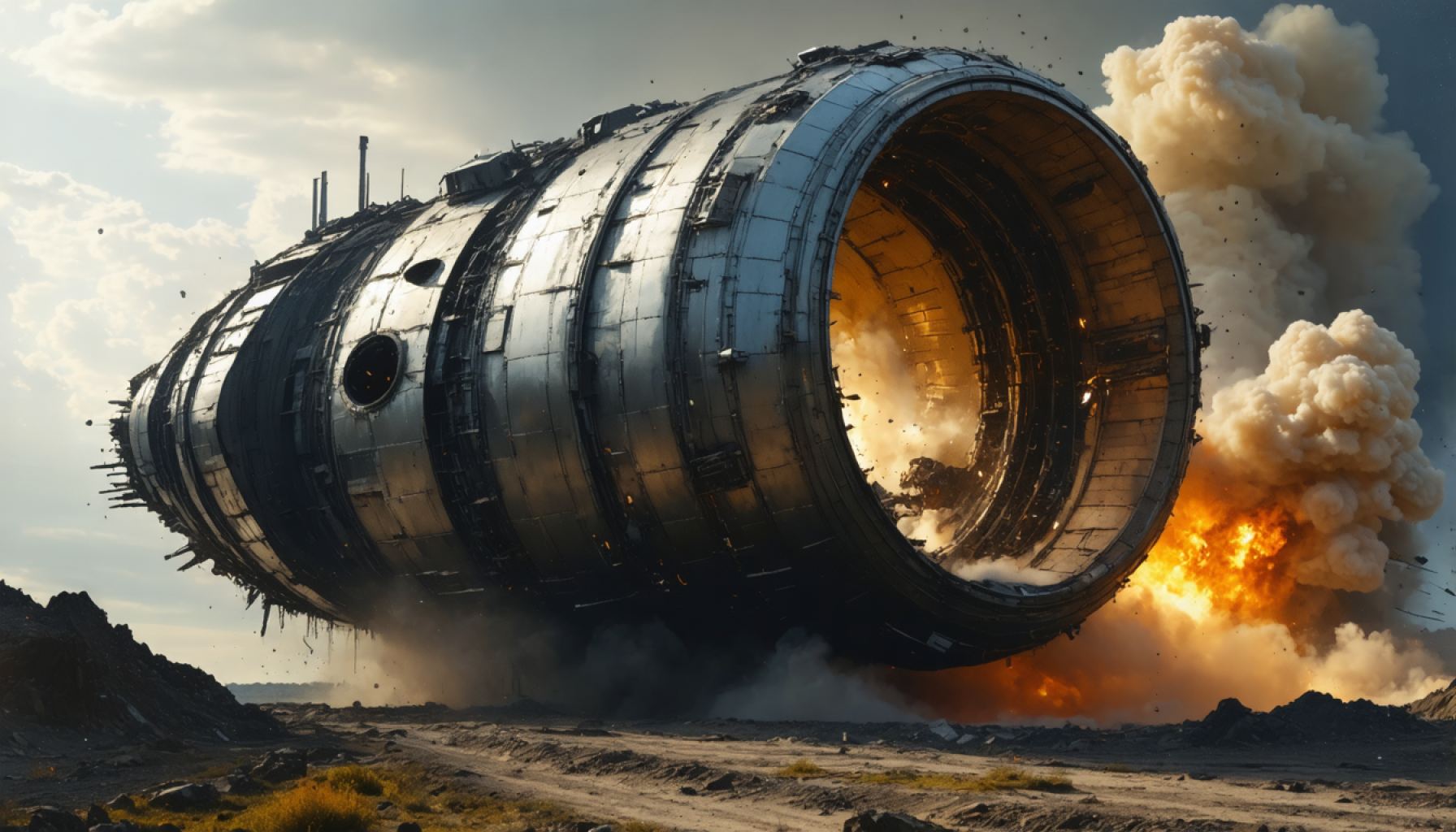- A piece of a SpaceX Falcon 9 rocket landed in the Polish village of Komorniki, discovered by Adam Burucki.
- The debris was part of an uncontrolled reentry after the rocket launched 22 Starlink satellites.
- Authorities, including the Polish Space Agency (POLSA), traced the fragment’s origin.
- An additional piece of debris was found nearby in the village of Wiry.
- The debris included a composite overwrapped pressure vessel, critical for rocket tank pressurization.
- A suspected technical failure prevented the second stage from landing in the ocean.
- The event underscores the potential risks associated with increasing space exploration activities.
- Expert Jonathan McDowell highlights the growing concern over space debris impacts on Earth.
Imagine waking up to find a charred piece of the cosmos at your doorstep. This surreal scene unfolded for Adam Burucki on a routine Wednesday morning in the tranquil Polish village of Komorniki. As he arrived at his warehouse, a colossal fragment of rocket debris lay ominously on his property. The massive hunk of metal, scarred and mysterious, sparked a flurry of activity.
Soon, officers from Poznan descended on the scene, joined by experts from the Polish Space Agency, POLSA. Their investigation unveiled the origin of this skyfallen visitor: a Falcon 9 rocket, the brainchild of Elon Musk’s SpaceX. Launched with 22 Starlink satellites, it had completed its mission and plummeted back in an uncontrolled reentry, leaving bewildered residents beneath a fiery meteor shower.
Burucki’s unsettling find was not the only one. Just a few miles away, another piece of the puzzle turned up in the village of Wiry. As news was pieced together, vivid imagery of the rocket stage bursting into flames while streaking across the Polish skies emerged, shared widely by awe-struck spectators.
At the heart of this chaotic descent was a composite overwrapped pressure vessel, crucial for pressurizing the rocket’s tanks. Experts speculate that a technical failure thwarted the second stage’s intended ocean landing, resulting in a blazing demise.
This incident serves as a stark reminder of the wavering line between triumph and disaster in space exploration. Harvard’s Jonathan McDowell cautions about the growing risks of these cosmic encounters. While Burucki’s tale ends safely, it echoes a broader concern: as our ventures into space multiply, so do the unpredictable returns to Earth.
What You Need to Know About Space Debris and Falcon 9’s Surprising Visit
How-To Steps & Life Hacks
Handling Space Debris Safely:
1. Do Not Touch: If you find space debris, do not touch or move it. Space debris can contain hazardous materials.
2. Contact Authorities: Immediately contact local law enforcement and space agencies for assessment and safe retrieval.
3. Document the Find: Take photos from a safe distance to help authorities identify the origin and details of the debris.
4. Notify Neighbors: Alert nearby residents to ensure their safety and gather additional observations.
Real-World Use Cases
Applications for Space Debris:
– Research Opportunities: Space agencies can analyze recovered debris to refine spacecraft materials and design safer reentry strategies.
– Public Awareness Campaigns: Incidents like these illustrate the need for better tracking of space objects, fostering public support for debris mitigation efforts.
Market Forecasts & Industry Trends
Space Debris Mitigation Market:
– Growth Projections: The global space debris mitigation market is expected to grow due to increased satellite launches and space activity.
– Innovations: Emerging technologies focus on capturing and removing space debris, such as nets, harpoons, and robotic arms.
Reviews & Comparisons
Falcon 9 vs. Other Rockets:
– Falcon 9, produced by SpaceX, is favored for its reusability and cost-effectiveness. However, its debris incidents highlight ongoing challenges.
– Other players like Blue Origin and ULA focus on similar sustainability but vary in technology and mission focus.
Controversies & Limitations
Space Debris Concerns:
– Environmental Risks: Uncontrolled descents pose risks to human safety and ecosystems.
– Legal Ambiguities: Current space law lacks comprehensive regulations to address debris liability.
Features, Specs & Pricing
– Falcon 9 Specs: A two-stage rocket with a height of 70 meters and a diameter of 3.7 meters.
– Pricing: Launch costs approximately $67 million as of recent estimates, known for its affordability compared to competitors.
Security & Sustainability
– Reusability: Falcon 9’s reusability aims to enhance sustainability but requires addressing challenges in controlled reentry.
– Regulations: SpaceX is actively working with agencies like the FCC and FAA to improve safety protocols.
Insights & Predictions
– Future Outlook: With the increase in space traffic, the importance of developing effective space debris management solutions is critical. Enhanced international cooperation is likely to foster better debris tracking systems.
Tutorials & Compatibility
– Tracking Space Objects: Amateur astronomers can contribute to space debris tracking using telescopic equipment and open-source software for community science projects.
Pros & Cons Overview
Pros:
– Cost-effective launch vehicle
– Reusable design lowers long-term costs
– Key role in satellite deployment
Cons:
– Risk of uncontrolled descent debris
– Potential environmental hazard
– Ongoing challenges in end-of-life rocket stage management
Actionable Recommendations
– Government Collaboration: Support initiatives for international regulations governing space debris management.
– Invest in Technology: Encourage investment in debris mitigation technologies, such as autonomous retrieval systems.
– Public Engagement: Participate in community science initiatives to track and report space debris incidents.
For further insights on space exploration and technology, visit SpaceX and POLSA.
By being proactive and informed, you can contribute to safer and more sustainable space exploration!
